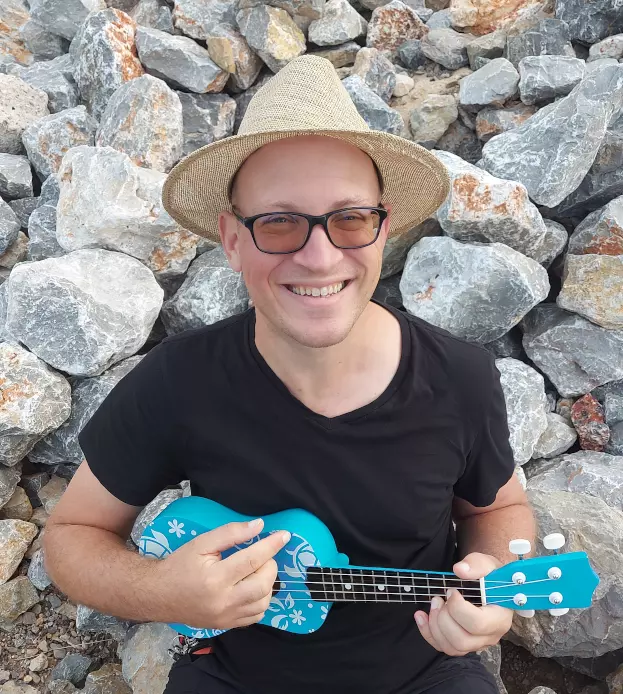
Hi, I'm Nicholas, your ukulele teacher
✨ 🎵 Learning with me is fun & relaxed!
- Patient & encouraging
- Music with a smile
- Personalized lessons
Ready to play? Let’s go!🎶🌟
Capo On Ukulele: 5 Simple Tricks To Sound Better!

What is it? Should you get one? Why use it for the ukulele? All you need to know.
How does a capo affect the sound of a guitar or the ukulele?
How does a capo function in musical instruments?
What is the significance of using a capo in playing certain chords?
How does a capo change the pitch of a guitar or a ukulele?
Do I need a capo as a beginner?
I see you have a lot of questions about the capo. Maybe you've heard of it. Maybe you have one, and don't know what to use it for? Is it really necessary anyway?
It's great questions, and I'm glad to explain everything you need to know about the capo today. :-)
- Table of Contents
- What's a capo?
- What is a capo for?
- Why using a capo for? 5 Simple Tricks To Sound Better!
- Experience something new
- Which one to choose for the ukulele?
- Which one to choose for the guitar?
- How to place a capo?
- Conclusion
What is the purpose of a capo in music? What do you need a capo for? When would you use a capo? What is a capo for ukulele? Capo for acoustic guitar? Why would you require a capo? What purpose does a capo serve? What are the reasons for needing a capo? In what situations would you find a capo useful? Can you explain the benefits of using a capo? The Capo: What is it? Why using it on a ukulele?
What's a capo?
You don't know what is a capo ?
You've probably seen one already.
We are not talking about a leader in the Mafia, a capo or caporegime. We'll talk about the capo used for ukulele or guitars, that is completely different!
A capo is a device that can be used in playing stringed instruments with frets, such as guitars or ukulele, to change the pitch of the strings without altering the finger positions.
(a fret is any of the thin strips of material, usually metal or plastic wire, inserted laterally along the neck or fretboard of a stringed instrument).
It is essentially a clamp that is placed on a specific fret of the instrument's neck.
It thus shortens the length of the strings.
A capo can be also named capodastro, or capotasto. It's the Italian for "head of fretboard". (yes, music is filled with Italian words!)
What is a capo for?
And how does a capo change the pitch of a ukulele?
A capo shortens the vibrating length of the strings.
What does it mean?
It means that the sound will get higher pitched.
Why using a capo for? 5 Simple Tricks To Sound Better!
What do you need a capo for?
Play easier chords
By shortening the vibrating length of the strings, the capo allows the player to transpose the key of a song in other tonalities.
Transposing the key can make it muche more easy to play.
If you play an A chord with a capo placed on the second fret, it is equivalent to a B chord.
So, instead of playing the somewhat hard B chord on the ukulele for which you have to bar, you just play a A with two fingers.
Easy!
Sing higher
It also means that if you want to play and sing a song higher pitched.
It is the very reason I've started to use a capo for some of the songs from my repertoire.
I learned them with specific chords. It was great to sing them in my flat.
But years later, when I started to play outside, for other people, I couldn't sing some of the songs as loud as I wanted.
The pitch was too low! If I wanted to sing louder, I had to sing a tone higher! That way, I would be more comfortable with my voice, and I could add more niceties.
Instead of learning new chords for those songs, I just tried them with a capo, et voilà!
Sometime I had to place the capo on the second fret (one tone higher). It really depends on the song.
Sing lower!
This part seems counter-intuitive!
Say you need to play the C chord, but need to sing 3 tone lower.
So it would be a F#.
Instead of changing all the chord to harder chords, you could place your capo on the 6th fret. That way, when you play a C chord, it will sound like a F# chord!
And you'll be able to sing 3 tones lower.
Sing lower: another way
One can tune down his instrument by a whole tone. That way, you could play lower, and sing lower.
For the ukulele, instead of G C E A, it will be F A# D G.
When you use a shape of a C chord, you will then play actually a A#.
To be able to play the chords "normally", you can then use a capo.
Bear in mind that the string will take some time to readjust to the new tuning. So you cannot tune down and then up every other day. Hence the use of a capo.
Fun fact: how many tones between the note C and the note C an octave higher?
An octave interval is 6 tones. It means that between an A note and another A one octave higher, there is 6 tones. Or 12 half a tone.
It means that if you play the E string open, and if you play the E string while pressing on the 12th fret, it will also be an E!
Why would it be interesting to use a capo for E?
It might be easier to use a capo, and put it on the 4th fret. So instead of playing a E, you'll play a C. It'd be much easier, right?
So if you can change all the chords of your song to match that, and still have other chords that are easy to play, you are in the sweet spot!
Your instrument is hard to play? Your right hand's fingertips hurt? use a capo!
Lastly, some ukulele or guitar could have a nut (the small part between the head of the guitar and neck) could be sometime a little too "big".
Sometime it has a white color. It is between the fret (black) and the head (wooden).
The strings then would be a little bit far from the neck, making it difficult to play on the first fret.
In other words, the action is too big.
The term 'action' refers to the distance between the fretboard to the the strings.
If the distance is too important, it starts to be harder to play.
So do you struggle to play with your index on the first fret for strings? Do you have to push too hard on the first fret to make a clear sound, compared to the other frets?
Then maybe using a capo on the first fret would be a great idea!
Experience something new
How can the capo can bring you something fresh, something new to your music?
How a capo could help you explore new things?
How to have fun with a capo?
Whether you're a beginner or more experienced, a capo can open up a whole new world of possibilities for your music.
For instance, you could play and sing higher, as already mentioned in this article.
You could also try playing all the chord higher. So instead of playing the voicing of C like this:
You could put a capo 5 and play the shape:
Much easier, but harder than a "normal" C.
You will sing, yourself, the same note, the same melody.
But the chord played will have more high pitched notes, even if it is still a C chord.
Higher means cuter for some music track.
It's the technique I use to play the beautiful Yellow by Coldplay. I put the capo on the 5th fret.
And it sounds gorgeous.
Which one to choose for the ukulele?
If you would like some more information:
Please write me a message in the comment section, and I'll be more than happy to help you!!
Which one to choose for the guitar?
If you would like some more information: Please write me a message in the comment section, and I'll be more than happy to help you!!
How to place a capo?
If you would like some more information: Please write me a message in the comment section, and I'll be more than happy to help you!!
Conclusion
So, whether you're a beginner or an experienced ukuleleist or guitarist, a capo can be useful in many cases:
- whether you would like to play simpler chords
- play a song you already know, but with lower or higher pitch
- or go easier on your left hand's fingertips
I hope this article has helped you :)
Have a fantastic day!
And you?
What do you use a capo for?
What kind of capo do you use?
What songs do you use your capo with?
Feel free to leave a comment below.

Hey there! Looking for a fun way to strum your way into the world of music?
Well, look no further! I'm Nicholas, your friendly ukulele teacher extraordinaire! With my expertise and a sprinkle of laughter, I'll have you strumming those strings like a pro in no time.
Get ready to unleash your inner musician and embark on a musical journey.
